Sourdough Bread Recipe
This basic Sourdough Bread Recipe produces an artisan loaf with a crisp crust and chewy crumb. It is best baked in a Dutch oven, but the recipe is very flexible and adaptable.
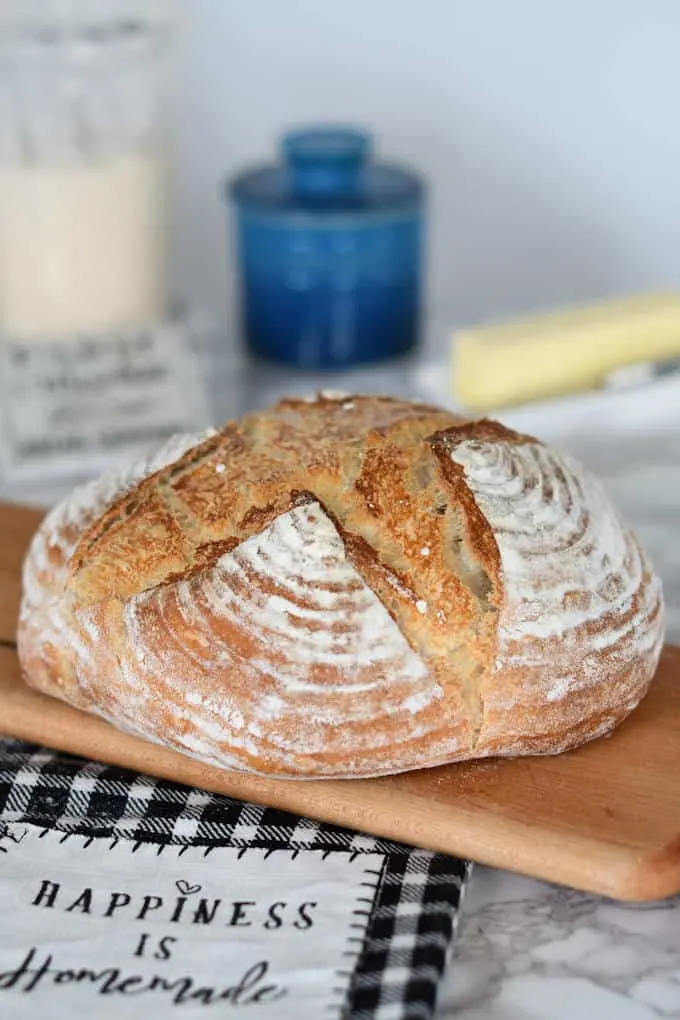
I think that this recipe for crusty sourdough bread is reason enough for making a sourdough starter. The wild yeast in sourdough starter makes an exceptionally delicious loaf of bread.
Because the bread freezes really well, I make a loaf of this Sourdough Bread each time I need to feed my sourdough starter.
What is Sourdough Bread?
Any bread that you make with a sourdough starter is a “sourdough” bread. There are a few key steps that will produce a light, crusty and chewy bread that is the quintessential loaf we all imagine when we hear “artisan sourdough bread ” .
What does the “hydration” percent mean for sourdough starter?
Hydration percent means the ratio of water to flour used for feeding your starter. If you feed your starter with equal weights of flour and water then your starter is 100% hydration. If you feed your starter with twice as much flour as water the hydration level is 50%.
Ingredients
- Active sourdough starter (100% hydration)
- Warm water
- Unbleached all purpose flour
- Salt
How to make Sourdough Bread

- The dough can be mixed by hand or on a stand mixer.
- The dough starts our quite sticky but will become more cohesive as it ferments.
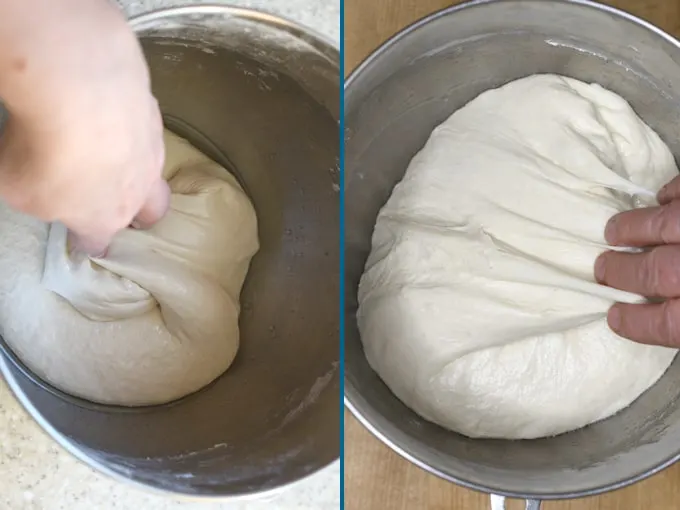
- Stretch and fold the dough several times during the initial fermentation.
- The dough will become more lively and aerated as it ferments.
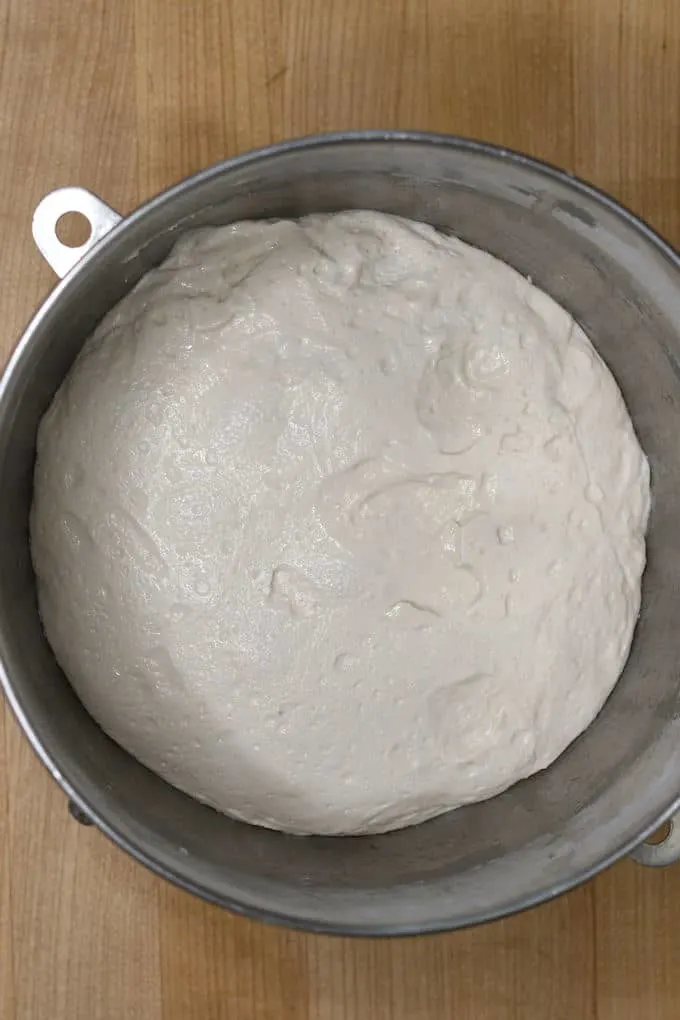
- Refrigerate the dough overnight. The dough can be refrigerated for up to 2 days.

- Turn the dough out onto a lightly floured surface.
- Use cupped hands to form the dough into a smooth ball.
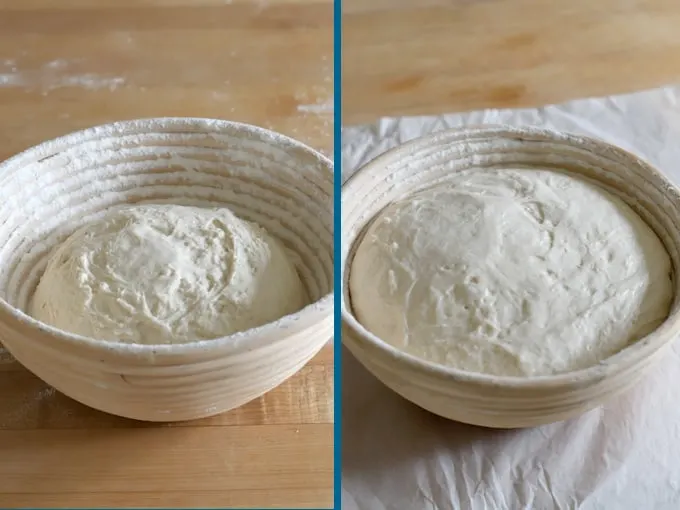
- Set the dough aside to rise for 2-3 hours until it doubles in size. The exact rise time will depend on the temperature of the dough and the ambient temperature.
- If you don’t have a proofing basket you can put the dough directly onto a piece of parchment paper for rising.
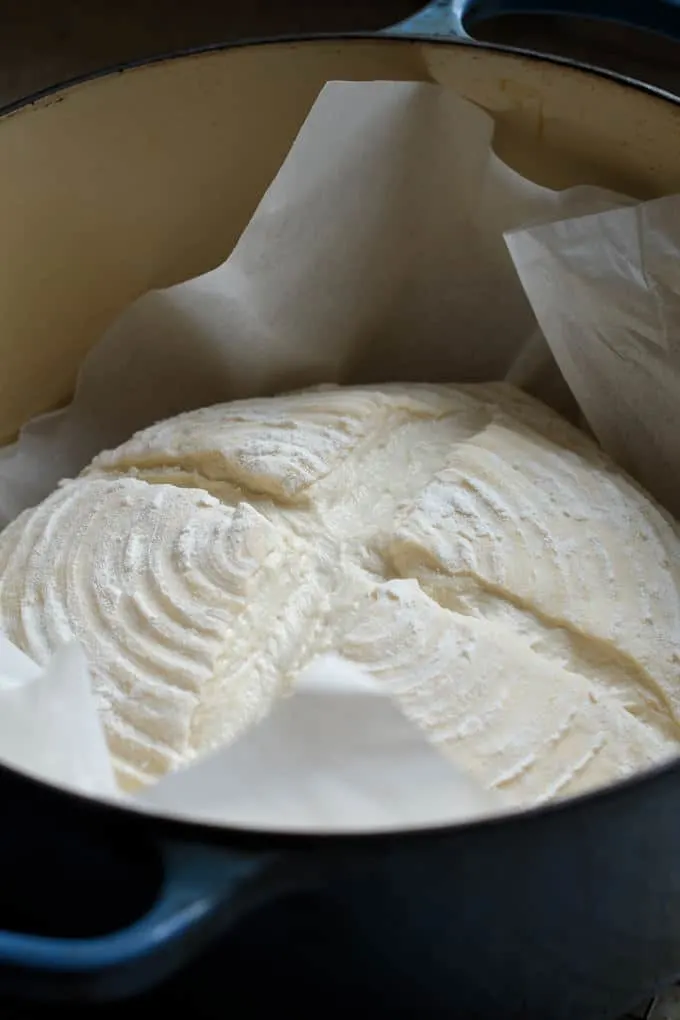
- Flip the loaf onto a piece of parchment paper, score the top, then use the paper to lower the loaf into the preheated Dutch oven.
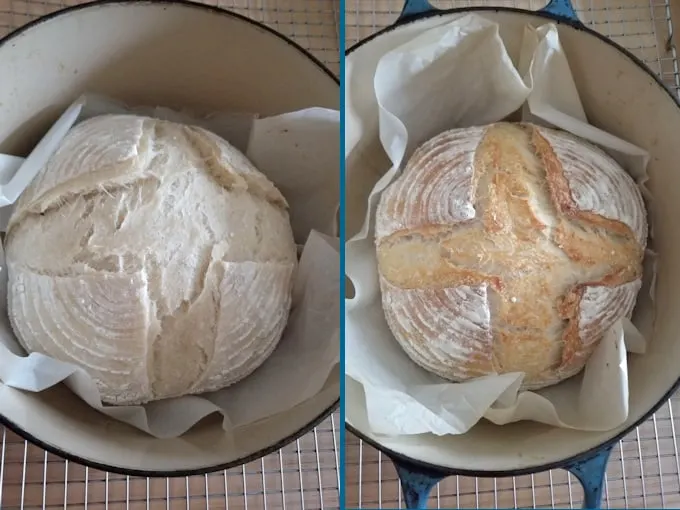
- After 20 minutes baking the loaf is well-risen but still pale.
- Remove the lid and continue baking another 20 minutes until the loaf is golden brown.
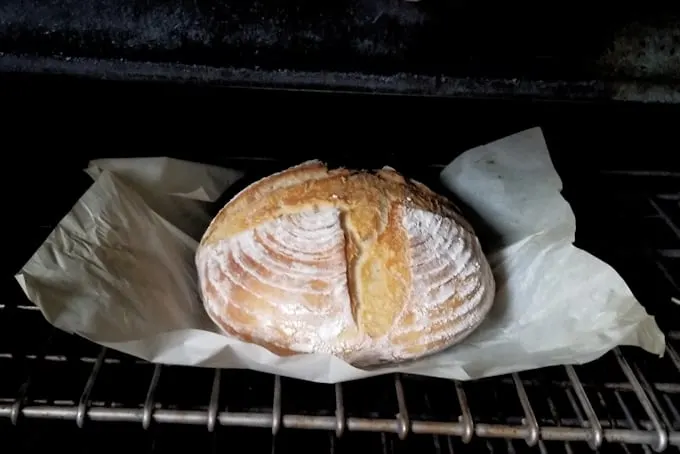
- Remove the loaf from the Dutch oven.
- If the crust is not quite brown enough you can return the loaf to the oven to finish baking until deeply golden brown and very crisp.
Timeline for making sourdough bread:
- If your starter needs feeding, do that the night before or early in the morning of the day you want to make the dough.
- Mix the dough in the afternoon. Allow it to ferment at room temperature all day and refrigerate the dough in the evening before going to bed.
- The dough can stay in the refrigerator for 2-3 days at this point.
- Take the dough out first thing in the morning and shape the loaf.
- Leave the loaf at room temperature to rise for 1 1/2- 2 hours.
- You should have fresh bread by lunch time.
Pastry Chef tips for making artisan Sourdough Bread at home
- A wet dough is a sticky dough and can be a bit fussy to handle. Because this bread has a long, slow fermentation, the bread has time to develop plenty of gluten without lots of kneading.
- The more lively and active your starter is, the better loaf you’ll produce. Use your starter after it’s been fed and just before it’s reached it’s peak rise.
- If you are working with a starter that is not 100% hydration you’ll need to adjust the amount of flour/water in the dough to allow for the difference.
- The Dutch oven creates a moist environment that develops that thick, crispy crust on the bread. Any oven-safe, heavy pot with a lid will work if you don’t have a Dutch oven.
FAQs for making sourdough bread at home:
Yes, start the dough early in the morning and skip the refrigeration step.
You can proof the dough right on the parchment paper that will go into the Dutch Oven.
Use any heavy, oven-safe pot with a lid, or slide the parchment onto a sheet pan to bake. The crust might not be quite as crisp as it is when baked in a Dutch oven.
You could try and shape this dough into a baguette. But I suggest you try this recipe for Sourdough Baguettes instead.
The bread keeps for 2-3 days at room temperature.
Yes! Store the loaf or slices in a freezer bag for up to 3 months.
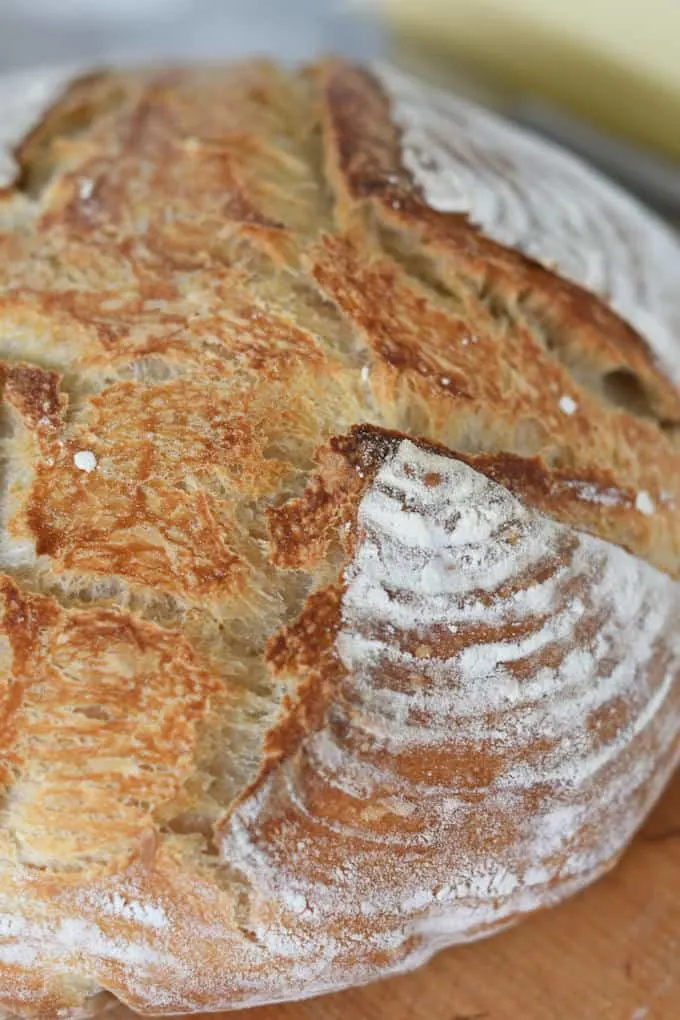
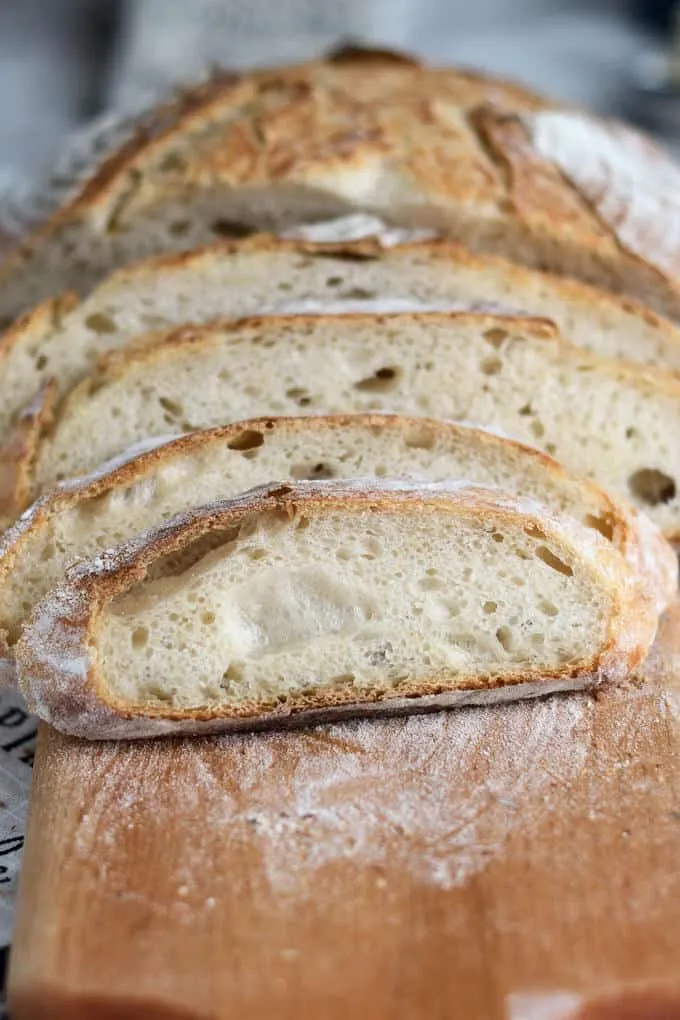
I know you hate to throw away that sourdough discard. Check out these recipes that use sourdough discard.
If you want to make a loaf with the crispiest crust ever, try making Sourdough Semolina Bread.
If you love this recipe as much as I do, I’d really appreciate a star rating and a quick comment. Ratings and comments help my recipes show in search results. Thanks!
Artisan Sourdough Bread Recipe
Ingredients
- 8 ounces active sourdough starter (1 cup (100% hydration))
- 8 ounces warm water (1 cup)
- 12 ½ ounces unbleached all purpose flour (2 ½ cups, see note)
- 1 ½ teaspoons table salt
- Rice flour for proofing basket
Instructions
- Combine 8 ounces active sourdough starter, 8 ounces warm water and 1 ½ cups (7 ½ oz) of the flour. Mix with the paddle on low speed until it forms a thick batter. Cover the bowl and set aside for 30-60 minutes.
- If using a stand mixer, change to the dough hook. Add 1 ½ teaspoons table salt and the rest of the flour and mix until the dough begins to form a ball around the hook. If mixing by hand add the flour using a wooden spoon and/or a plastic bowl scraper. This dough is quite sticky.
- Place the dough into a lightly oiled bowl, turn once to coat the dough. Cover the bowl and set it aside at room temperature.
- After 60 minutes uncover the bowl, lift one side of the dough and fold it into the middle of the dough. Repeat with the other three sides of the dough then flip the dough over. You're basically turning the dough inside-out to redistribute the yeast. Cover the bowl and every hour or so repeat the procedure.
- After about 2 hours the dough should be lively, elastic and airy. If the dough is still sluggish give it another hour or two at room temperature. Cover tightly and refrigerate overnight.
- Remove the dough from the refrigerator and dump it onto floured surface. Without kneading, use your cupped hands to form the dough into a smooth ball. Cover lightly with a kitchen towel or plastic wrap and let the dough rest for 20-30 minutes. If the ball flattens during the 20 minutes fold it onto itself and form the ball again. This step will help you check if your dough is elastic enough to help it’s shape during the final rise and baking.
- Uncover the dough and knead 1-2 times. Reshape the dough into a smooth ball and place the dough into a well-floured proofing basket (I use a mix of ½ rice flour and ½ all purpose flour in the basket) or directly onto a sheet of parchment paper.
- Cover the dough and leave in a warm place until it's almost doubled in size and it springs back slowly when poked, about 2 hours depending on the room temperature and dough temperature. Meanwhile, preheat the oven to 425°F. Place a Dutch oven with a lid into the oven to preheat.
- If the loaf is in a proofing basket, place a sheet of parchment over the dough and gently flip it over. Use a single edge razor or very sharp knife to cut a ¼" deep X across the top of the loaf. Remove the preheated pan from the oven and remove the lid. Use the parchment to lift the loaf into the Dutch oven.
- Replace the lid on the pot and slide it into the oven. Bake for 20 minutes. Remove the lid from the Dutch oven. The loaf should be well risen and pale in color.
- Continue baking another 20 minutes until the loaf is nicely browned and beginning to crisp. Remove the pan from the oven. Use the parchment to lift the loaf out of the pan. Use the parchment to place the loaf directly onto the rack in the oven. Bake another 5-10 minutes until the loaf is deeply browned and very crisp. Total baking time is about 40-50 minutes.
- Cool completely on a wire rack before slicing.
Would you like to save this recipe?
As an Amazon Associate and member of other affiliate programs, I earn from qualifying purchases.


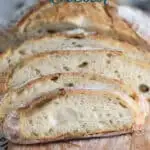






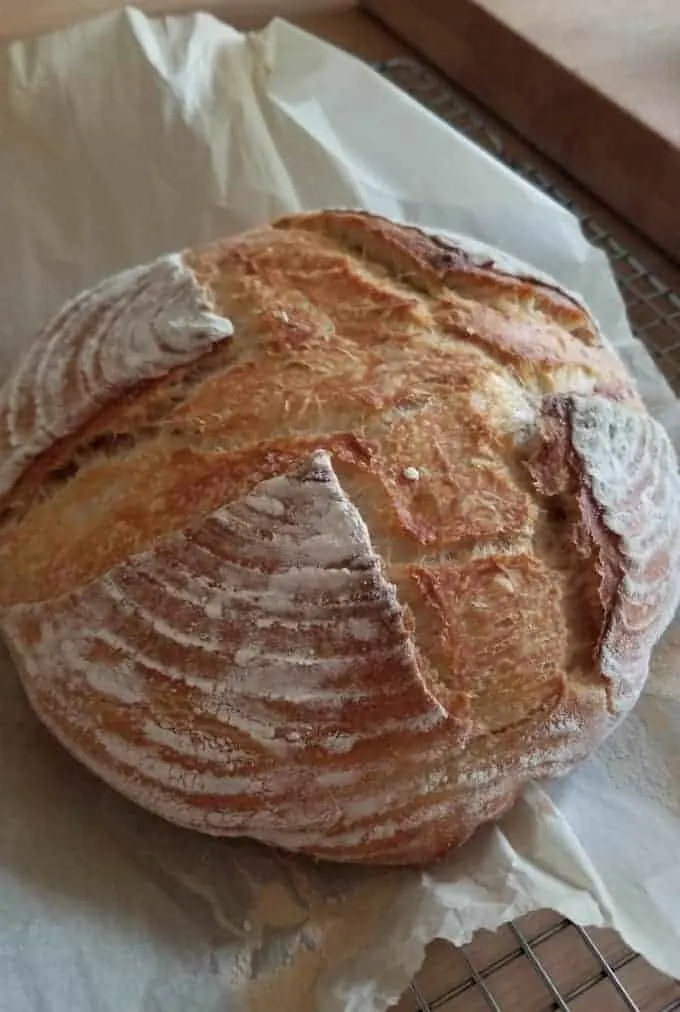
Your directions in step 1 say to use 1 1/2 cups of flour but then below that you give the entire 2 1/2 cup amount in grams. I wasn’t paying attention and added the 354 g all at once so now all I would have left to add in step 2 is the salt. This should be updated to not cause confusion to beginner bakers.
Do you think the loaf will still turn out or do you think there will be an issue with adding it all at once?
The bread should be fine. I’ve updated the card.
Your recipes for sourdough bread are the only ones I’ve ever had good luck with…starting during the shut-down days of 2020. I almost lost them but remembered Baking Sense tonight. My loaves always turned out Beautifully when I followed your directions.
Thank you!
I’m wondering why you changed this recipe? You used to have us turning and folding the dough every 30 minutes, then every 60 minutes, adding up to 3 hours. Plus a few other changes I noticed. Just curious. I’ve always loved this recipe – my bread has always come out perfect.
Hi Laurie, thanks for the question. I’m am always trying to improve my recipes and I’ve been tweaking the instructions in all my sourdough recipes to try to convey that it’s not an exact science set on an exact schedule. So I’ve been giving slightly looser instructions because the dough will behave differently depending on your environment and your starter. Sometimes the dough may be ready in 2 hours and sometimes 5 hours. If your bread has been coming out perfect then definitely no need to change your procedure.
@Eileen Gray, thanks!
@Eileen Gray, my dough took nearly 48 hours to be ready, partly because our house sits at 69 degrees, partly because I didn’t turn it as often as I was supposed to with kid distractions. I also think my starter was somewhat sleepy with me returning from a trip prior to me doing this.
What using minimal starter, a slow bulk ferment, and a cold second proof is that it results in an incredibly amazing flavor profile. After taking a side road this past year that’s been fraught with frustration, I’ve come back to this simple, basic recipe where I started in order to refine mixing technique, bulking time, hydration and oven spring with the relatively weak, organic, non-hybridized flours that I use that only contain around 10-12% protein.
Even a loaf having less than an ideal height and having a bit tighter crumb is still soft and flavorful.
Thanks Eileen. Now please pass the butter.
A note for those who don’t already do so – weigh your flour and water. You may realize improved and more consistent results. So, do yourselves a huge favor; buy a scale and click the ‘metric’ button.
I make 7 loaves at a time. Some of my loaves do not rise as much as I’d like but the holes, taste, crust is good. What would cause some loaves to rise less than others?
Do you make a 7x batch or split the dough into 7? So many factors could affect the rise. Ambient temp, dough temp, condition of the starter. Do all the loaves comes from the same batch of dough?
@Eileen Gray, 7 times the batch but it is a recipe from Kristen’s fool proof so not yours.
I made your rolls and I’m very happy with them so will also try your bread recipe. I struggle with the poke test and knowing when processing is ready for fridge. It’s usually around 7 hours from when I add the leaven. Thank you for your recipes and help.